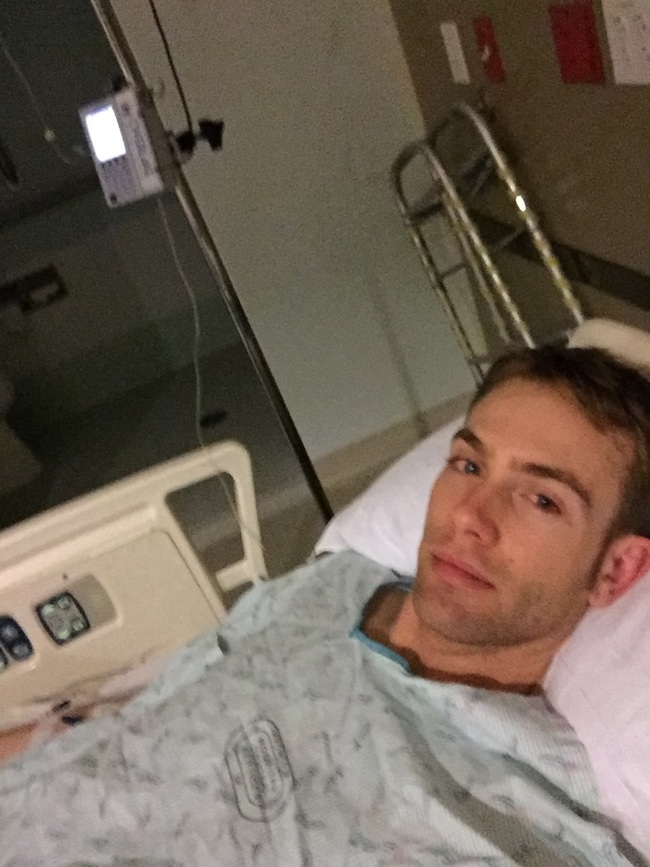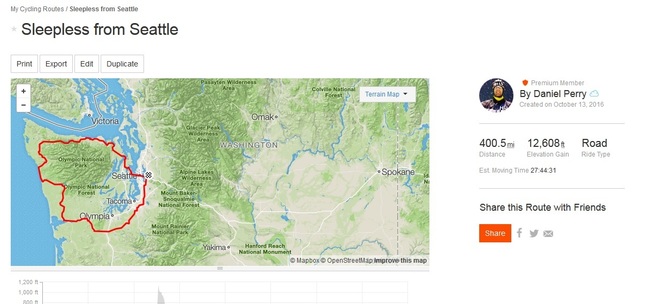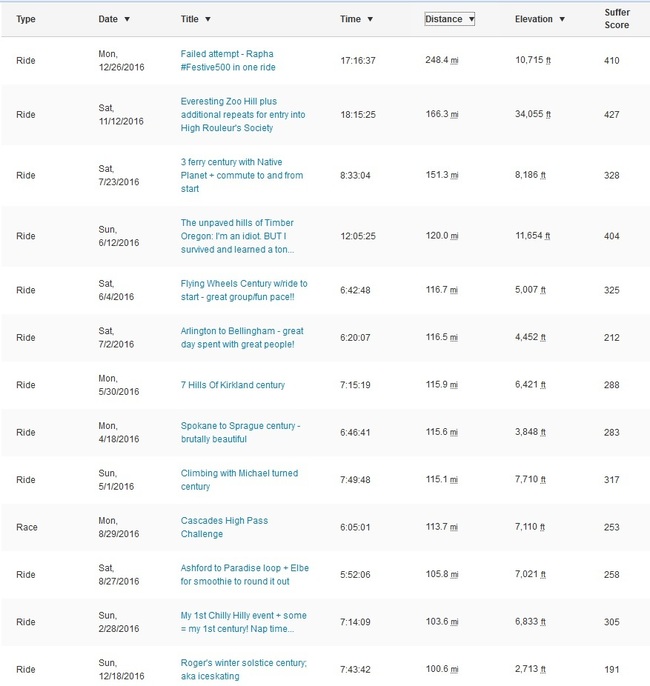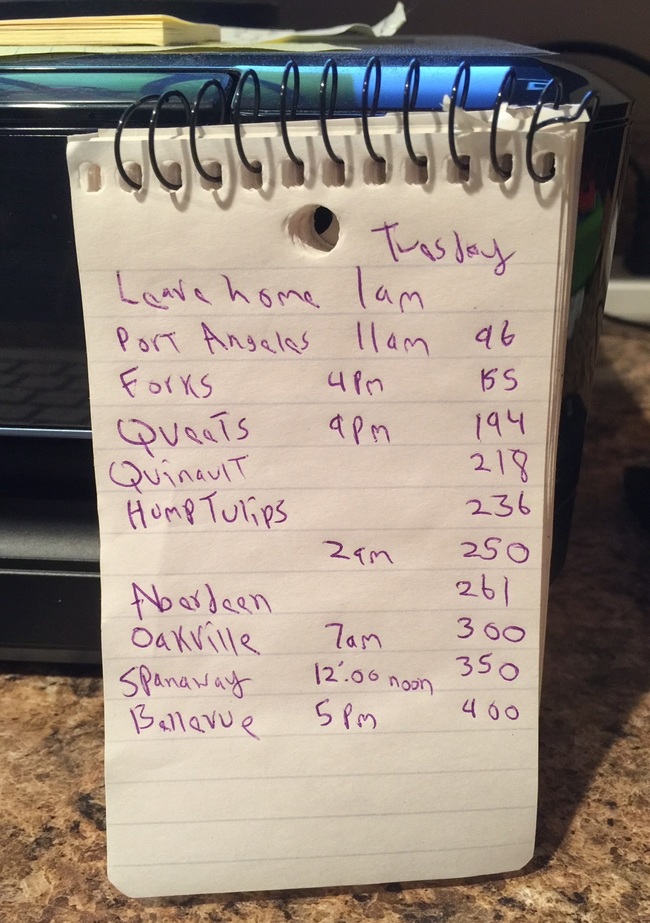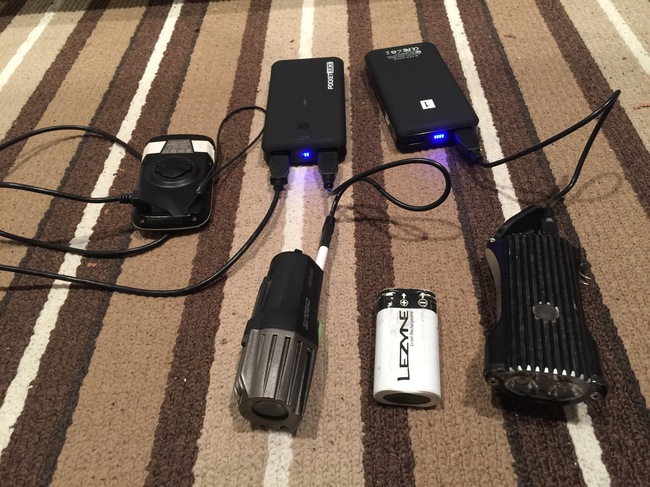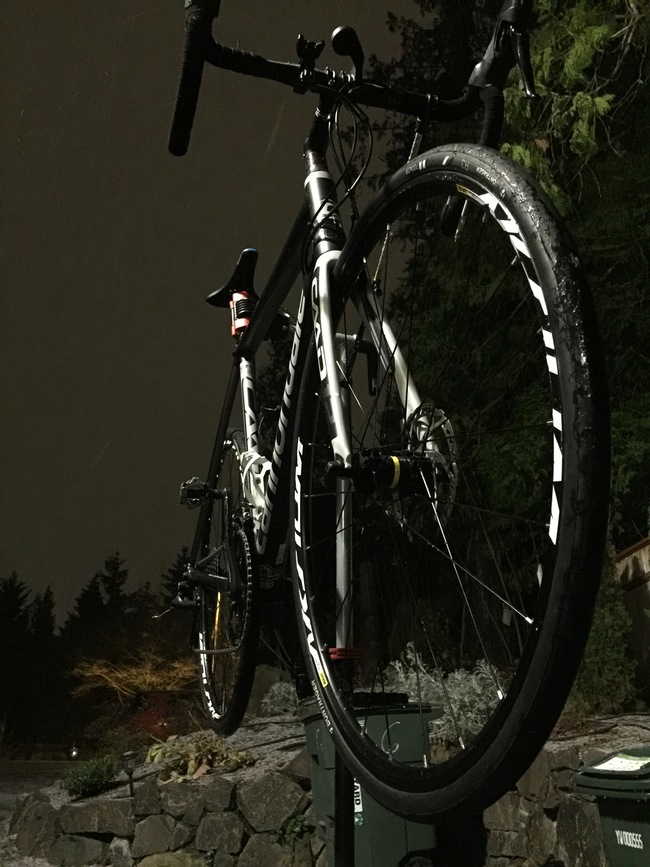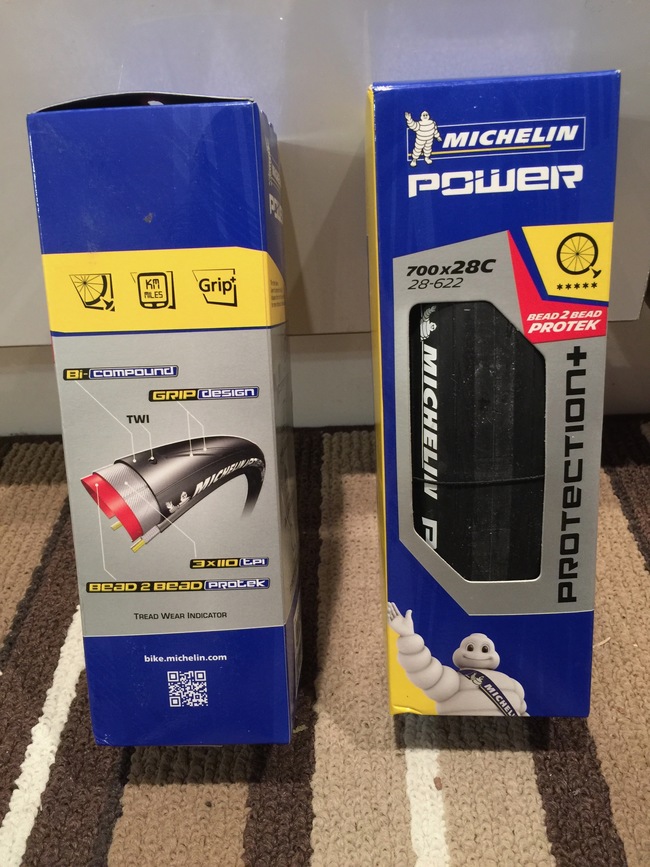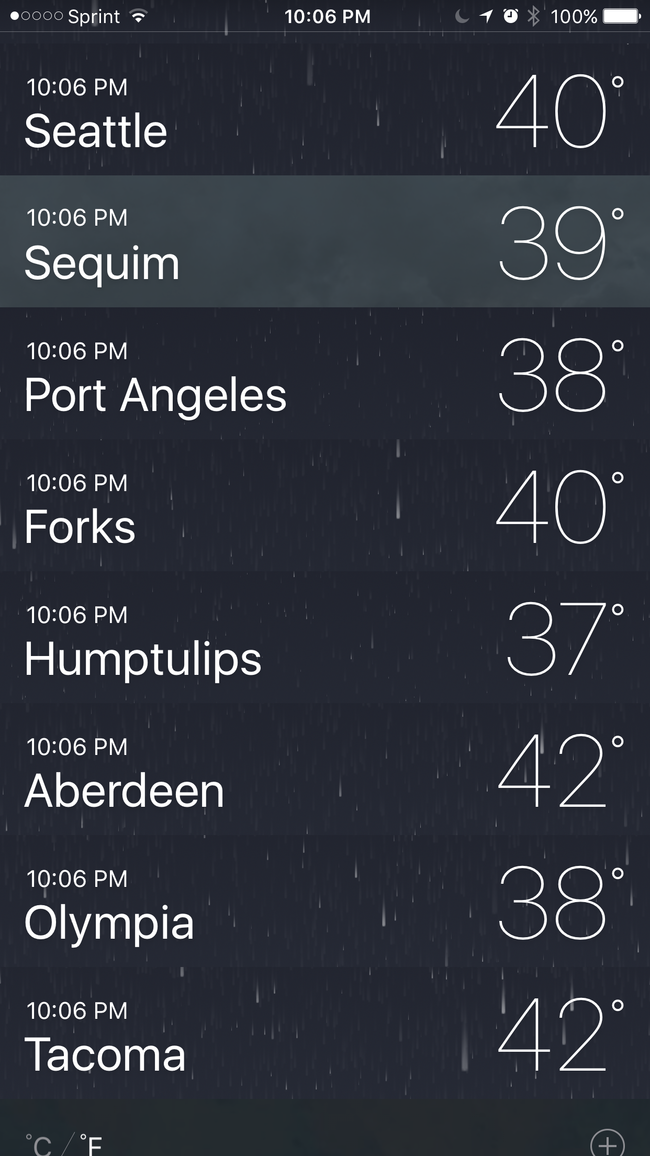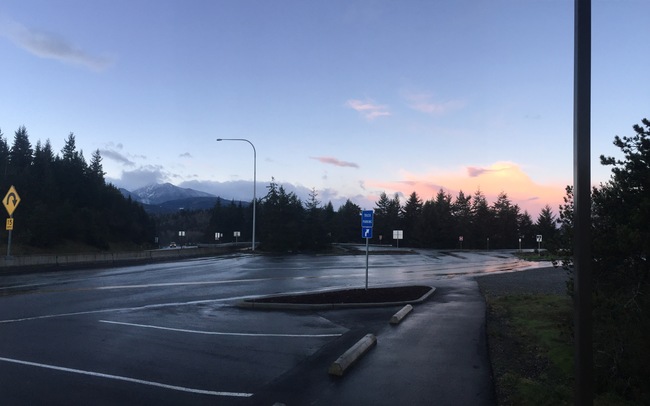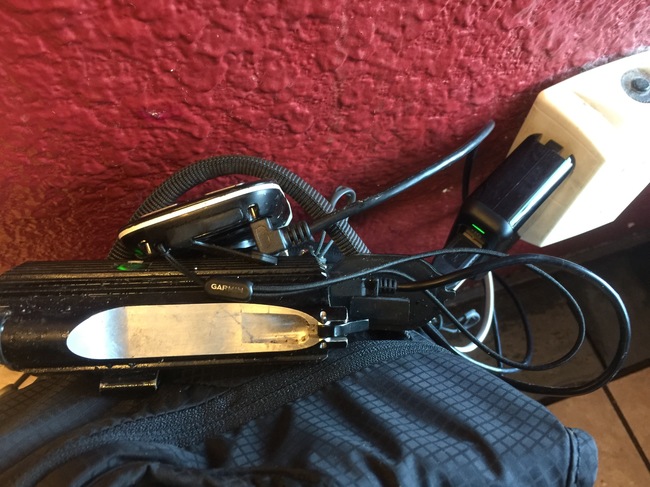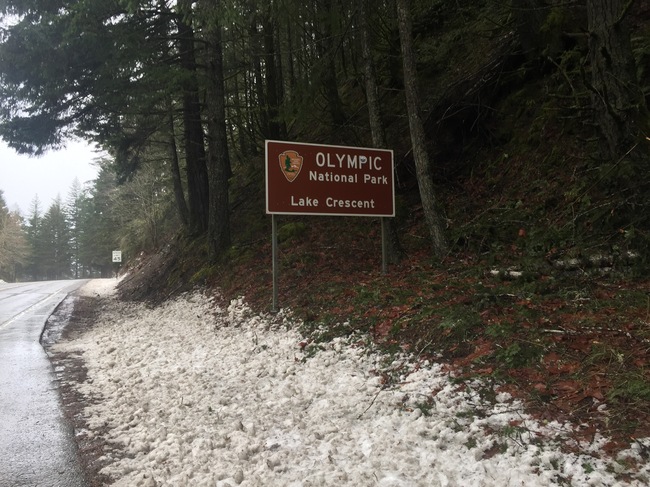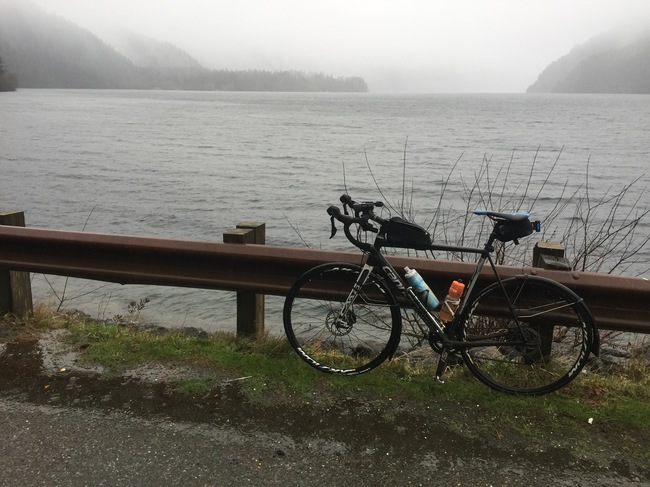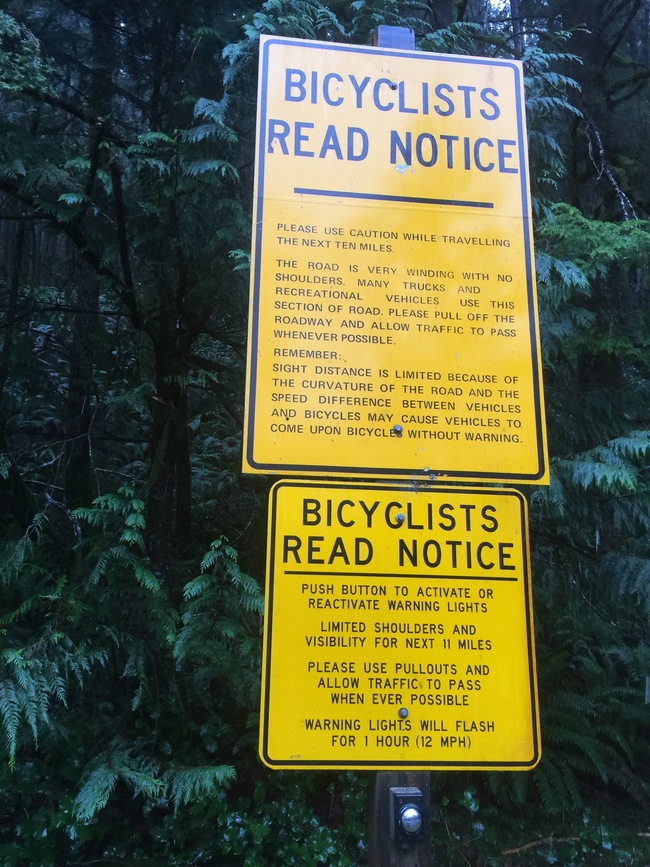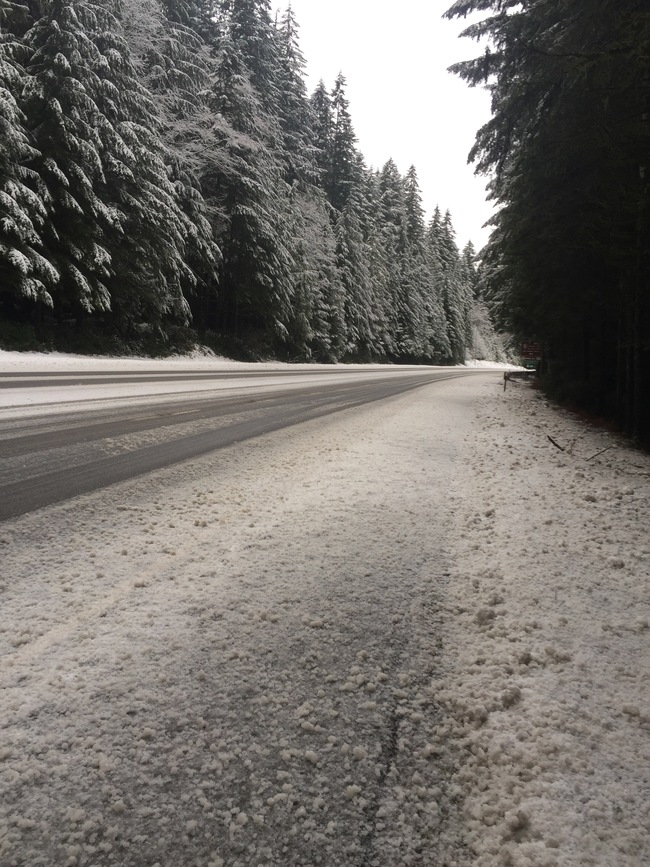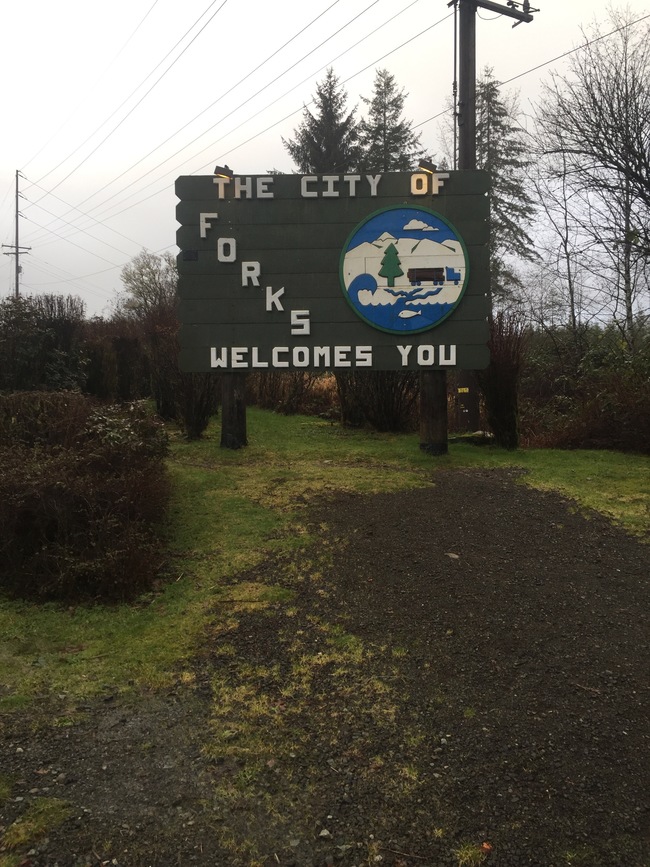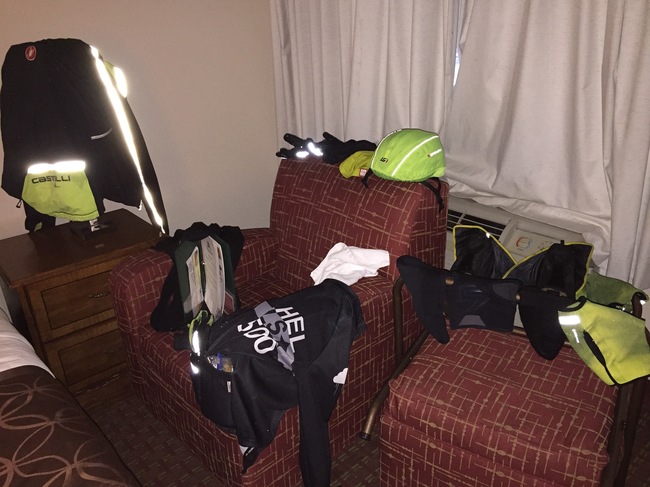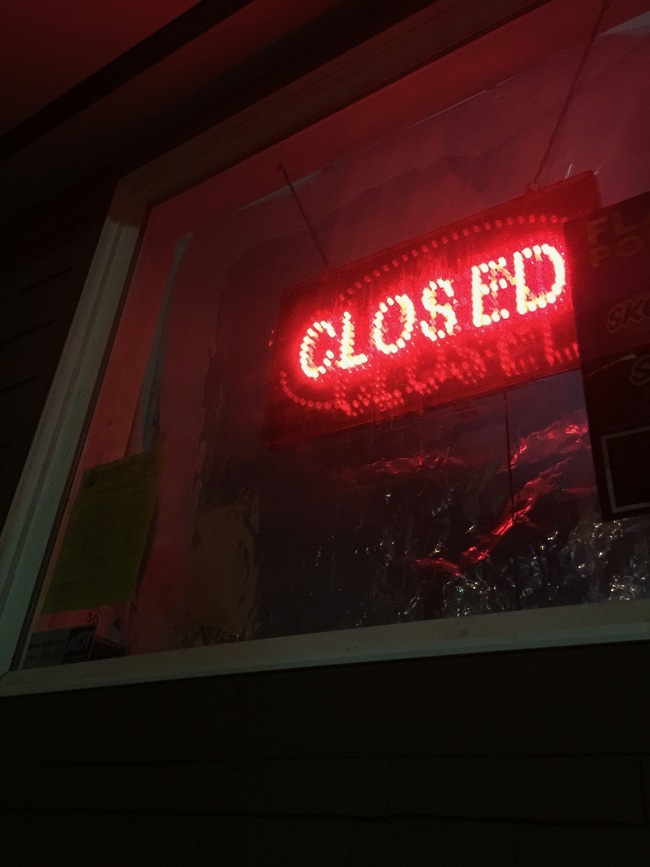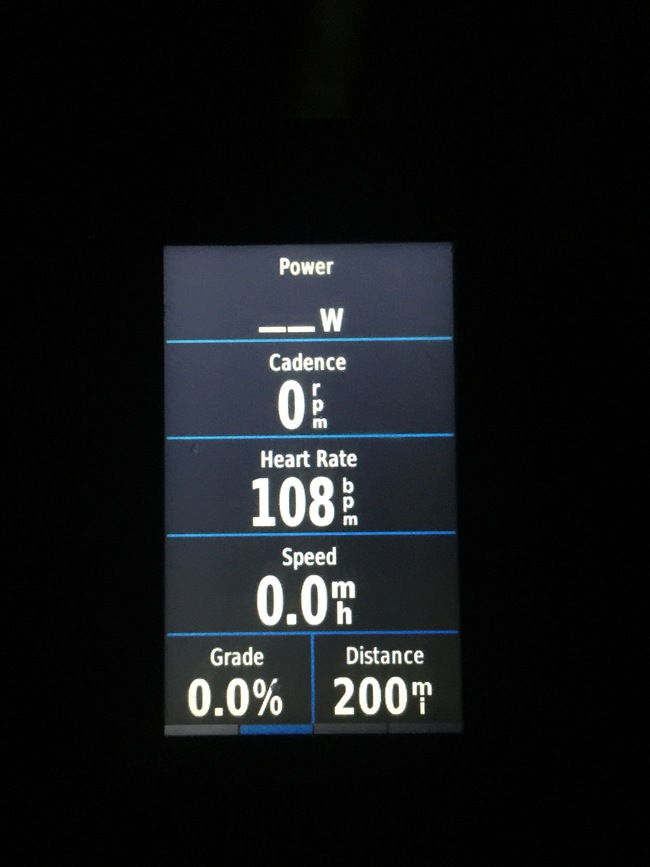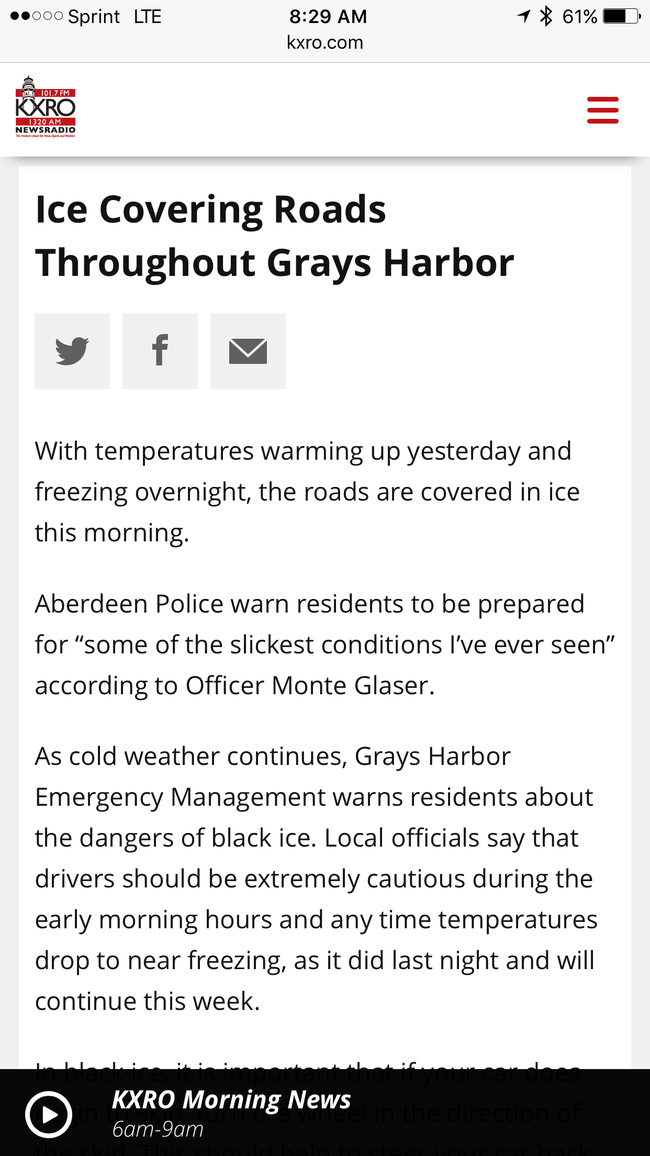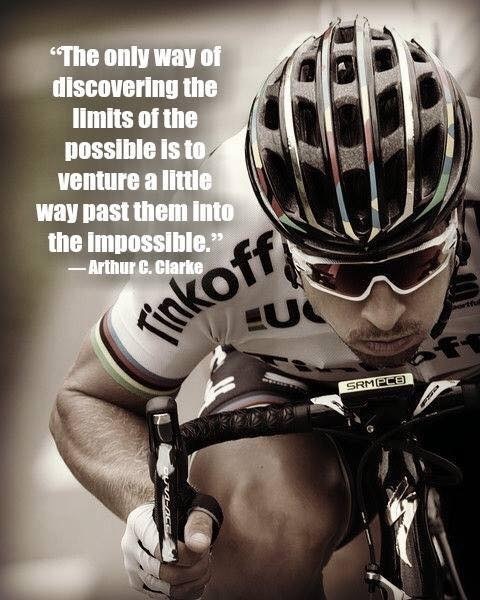Rapha #Festive500 in one ride
This undertaking began in 2015.
I got on a bike for the first time since I was a kid in July 2015 and began using Strava within two weeks. The first time I really pushed for a goal was a Strava climbing challenge in October that year. It was more physical effort than I had extended my entire life, but I was able to complete the challenge and even bought the jersey I couldn’t afford because I was so excited about what I had done!
I completed the next climbing challenge in November. It required less elevation, but was no less difficult because of the weather. I also had only one bike which a friend had given to me. It was a steel Schwinn Le Tour someone had converted to flat handlebars. It had head tube shifters. And the brakes - terrible brakes on chromed wheels. Every time you go up, you have to come back down, and it was often terrifying.
December rolled around and I had spent more money I didn’t have on clothing so I could continue to enjoy the sport that found me; even in the cold and wet Seattle weather. I entered another climbing challenge and also read about some company I had never heard of called Rapha. They were challenging people to ride a bike at least 500km during the 8 days between Christmas Eve and New Years Eve. I had no idea if I could do it, but I hit the “join” button anyway.
I began planning and doing math. How much distance should I do each day? Would I need to take time off work? Should I have a rest day in the middle? Then it happened. On a bike ride of course, how else?
I thought my lunch simply hadn’t agreed with me as I wheeled my bike onto the road after work. I shrugged it off. Either the pain in my abdomen would improve or I would puke out lunch; either way I was riding my bike so how bad could it be? It got worse, much worse. And I never did see my lunch again. After I got home and showered, I writhed in bed until 2am when I decided the hospital was a valid option. I hardly ever see a doctor but I’m so glad I did.
By 10:00am my appendix was out and in the nick of time; it had not ruptured. I went home the same day. During my release interview, the nurse advised no physical activity for 2-3 weeks. After many defining questions she must have thought I was nuts, but then she hadn’t heard of Rapha either. I went home dejected. The next day I returned for a checkup and asked the doctor more questions about “physical activity.” His response was to let me know the nurse was wrong; no physical activity for 4-6 weeks. What?!
I spent the rest of December off the bike watching both the climbing challenge and the Rapha #Festive500 pass without me. Bummer.
Fast-forward to the following December 2016. It was quite a year. After about 8,000 miles including a successful Everesting attempt, I was looking forward to the Rapha #Festive500 and in good health.
But how to do it? I wanted something that would push my limits. Not that 500km (310 miles) during 8 days in December was easy. It’s just that I knew I could. Where was the challenge then?
Back in October I had created a few routes after looking at my Strava heat map It is a fun feature which shows a world map highlighting all the roads and trails I had ridden a bike on. The routes I created filled some of the areas I had not yet ridden. One of them was a loop around the Olympic Peninsula. It had been a curiosity, a wandering of the mind to know the distance. It was never supposed to be a ride I would plan. But there it was. A challenge I knew was possible because I had watched the likes of Brian Toone and the Hells500 throughout the year. But was it possible for me?
It didn’t take long for the planning to begin. I lightly modified the route. It would be 401 miles and 12,000 feet elevation gain from my door around the peninsula back to my house. My Everesting had given me some insight into nutrition needs over a long period of time and fatigue/sleep deprivation, but this would be different. I would have no bailout options and much of the route is very remote.
The Everesting had taken just under 24 hours to complete, of which about 18 hours was moving time. I studied my century (100+ mile) rides over the last year and decided I would give myself 10 hours per century. So that would be 40 hours total.
I have never been able to sleep well the night before a big ride. I guess I’m just too excited and I toss and turn, unable to shut my mind off. Because of this, quality sleep needs to happen the two nights before an effort and start time is a bit irrelevant.
At first I thought to do this over the Christmas weekend. Then I realized many of the businesses along the way I would depend on would be closed or have severely limited hours. I put in a request for time off at work. Christmas 2016 fell on a Sunday. I would go back to work Monday, sleep if I could until midnight, and catch the last ferry to Bainbridge Island. If things went to schedule, I would be home just after dark on Wednesday and have just enough time to sleep before work the next day.
With a route and schedule, I started planning the intimate details. Order chamois cream. Buy chemical hand and toe warmers. Research the weather (we’ll get back to this one). What food to carry. Etc etc.
A big challenge would be the dark. This ride would start and end in the dark as well as pass through an entire night in the middle. A quick look at Weather Underground showed about 8 hours of daylight. That meant I needed enough headlight power for approximately 24 hours of darkness. Good news! I had a USB battery pack. I read the label: 2,000mAh. Hmm, no conversion calculator online for this one. I tested it by recharging my Garmin. From 10% to 97%. Once. Oh boy.
A good riding companion Michael was willing to loan me his 6,000mAh battery pack AND his new headlight! Fantastic. More testing showed his battery pack would recharge his headlight and mine. Once. That got me about 8-9 hours of light. Oh boy again.
Some shopping around landed me two 12,000mAh battery packs from Best Buy for $20 each. They had charge level indicators and two charge ports each with fast charge capability. Score! I found Michael’s headlight would last about 5 hours on a conservative setting. My headlight had two battery packs and each was good for 3-4 hours. Having two lights would allow one to be in use while the other recharged. These battery packs were very important if I was going to complete in 40 hours; no time to stop for hours at a time and charge up in some coffee shop along the way! I also had to purchase a shorter charge cable for my phone and a charge cable for the Garmin with a 90 degree angle so that it could be charged while in use on the bike mount.
Next was nutrition and hydration. I wasn’t very concerned about the first century. It would put me in Port Angeles around 11:00am; a town with lots of resources to choose from. The next stop would be Forks (of Twilight fame) around 4pm and 150 miles. Still early enough to find a store and stock up. The next stretch was more difficult. Most of the space between Forks and Aberdeen is remote Indian reservation and National Park. There are two or three gas stations but I could not determine their hours by looking online and no one answered the listed phone numbers. I wouldn’t reach Aberdeen until about 3am which meant I might not find any stores open there either. This left me planning for a 150 mile gap between services until Oakville at around 7:00am; the second 150 miles. In the dark. On roads I had never explored outside of a car. And my longest ride to date was 166 miles total. What was I getting myself into?
I had an Osprey Rapter 10 hydration backpack which held 3-liters of water in addition to two large water bottles on the bike. I would then find a way to stuff my nutrition around everything else inside the backpack. Nutrition would be strictly foods I had found palatable on previous rides:
- 4 peanut butter and jelly sandwiches
- 6 mini bagels with cream cheese
- 12 Gu energy gels (6 of them non-caffeinated)
- 6 packs of Pro Bar energy chews
- 10 XS Sports Nutrition energy bars
- 6 golden double-stuff Oreos Fitting all this into the hydration pack should earn me a permanent line on my resume. I wouldn’t call it art, but thanks to ziplock bags everything remained edible.
What about the bike? I actually had little concern here. The Cannondale CAAD 12 had been trustworthy through many things and, although this would be a trying ride, in the grand scheme of things it was just another 400 miles to the bike.
With a new chain and newish brakes, I felt comfortable with only upgrading the tires. I chose something I hoped would spare me some punctures. I went with Michelins Power Protection+ in 700x28.
I managed to stuff 3 tubes, a multi-tool, 2 tires levers, a patch kit, and tire boots into my tried and true seat bag. A spare folding tire, master link for the chain, spoke “repair” kit, zip ties, and tape found space in the hydration pack. Although loath to mar the look of the bike, I experimented with top tube bags in order to hold my battery packs. With help from Michael again and also Craig I settled on the Revelate Designs bag. It had enough room for one of the battery packs, spare battery for my headlight, my phone, all the charge cables, and most importantly enough room for the cables to plug into the battery pack!
Last, clothing. This would completely depend on the weather. I had plenty of foul weather in the weeks leading up to the ride to test things out. None of this would be sufficient in the end, but this is what I took:
- waterproof socks from SealSkinz
- my only cycling shoes, Giro Rumble VR’s
- Mavic Krysium insulated shoe covers
- Garneau Neo Protect II shoe covers (neoprene)
- De Marchi thermal tights
- Verge Sport tech base layer (short sleeve)
- Under Armour base layer (long sleeve)
- Nemesis thermal jersey (long sleeve)
- Nemesis wind vest
- Castelli Conforti rain jacket
- Air Hole face mask/buff
- De Marchi headband/ear covers
- Garneau waterproof helmet cover
- Specialized Deflect H2O Therminal gloves
- backup pair of Castelli gloves
Incidentals included:
- 4-port USB wall charger (just in case)
- tissues and toilet paper in a ziplock bag
- basic bandage/med kit
- lots of hand and toe warmer chemical packs
- Salt Stick fast chews
- Ibuprofen
- ear buds
- DZ Nuts chamois creme
- lip balm
- emergency blanket
- paracord bracelet
Whew. That all sounds heavy! I didn’t weigh everything together, but the backpack was 17 pounds and I’m guessing the extra clothing, loaded top tube bag, and second headlight all added up to at least another 5 pounds beyond a typical ride weight.
Leading up to the ride I was also struggling with some severe pain in my left knee. It had been an issue since I tried to be a runner years ago, but the Everesting really set it off in November. I bought KT tape and tried that on a ride, no improvement. I settled on a Shock Doctor neoprene knee brace. It helped hold everything together at least.
Okay everything was settled then right? Well, other than the fact that this was December in the Pacific Northwest, yes I suppose it was. I set up all the towns I would pass through in the Weather app on my iPhone. Then I went online and researched weather history for the region I would be traveling through. The result? It would be winter, but nothing I hadn’t already experienced. I set a threshold and checked the weather daily for about a week leading up to the ride. Any town with a low temperature below 34 degrees would cancel the ride. Also, ANY chance of snow would cancel. The week before the ride I joined some friends for a winter solstice century ride and we found ice. It was both painful (to fall on) and incredibly humbling. I wanted no repeats.
The weather looked okay, estimated temperatures even ROSE on Monday before the ride! I was excited. I didn’t tell many people what I planned because I knew it wasn’t necessarily safe and I didn’t want anyone talking me out of it.
I was diligent and got 10-12 hours of sleep on both Christmas Eve and Christmas day. I got up for work at 7:30am Monday. I was home from work and had everything ready by about 7:00pm. I laid down in bed and attempted to sleep. True to past experience I could barely keep my eyes closed let alone sleep. So I laid and rested as long as I could stand it. I jumped out of bed at 10:00pm and checked the ferry schedule. I could make the 12:45 instead of waiting until the 2:10am as planned! Why wait? I wasn’t going to sleep and my body was as rested as it could be otherwise. So I hit that big red button all the great movies teach you not to press:
I was already getting odd looks from drivers as I shivered behind a pillar on the ferry dock. It was windy and the roads were wet but it was not raining. Once on board, went inside to stay warm and posted a placeholder activity to Strava and Instagram so that anyone who was interested would have a place to see updates from me. This is the last time my feet would be warm until Forks.
Bainbridge Island was cold and dark. By the time I crossed the Hood Canal bridge I was second guessing how flat I thought the route would be. None of the hills were particularly long or steep, but when you’re goal is to expend as little energy as possible they seem to take forever to climb!
I found snow for the first time somewhere before Blyn at only 500 feet elevation. It kind of freaked me out. I wasn’t expecting snow AT ALL. It had recently fallen and was only on the shoulder. I experimented with traction and found it was not icy and my tires easily cut through it.
This is where the only tire puncture of the trip happened. I think it was glass but I’m still not confident. It was a slow leak in the rear and I had time to find a safe spot to replace the tube away from passing trucks; my only companions at about 4:00am. New tube in, I set out. And immediately stopped with a very evident bounce to the tire. I found the bead would not seat in the wheel at the valve stem. I thought the tube was too large (28-38). Tire off and repositioned I tried again. This time the bead seat failed so bad the tube popped out. Luckily I caught it before it was damaged. I repositioned everything and tried again. The tire still hopped a bit, but the tube stayed in and I was so cold I decided I didn’t care.
Passing through Sequim I was treated to some beautiful Christmas light displays. They also had a well appointed rest stop which included, to my delight, a lighted restroom WITH HEAT! I tried to revive the chemical warmers in my shoes but with little success.
The section of highway 101 from Sequim to Port Angeles was nasty. There was far more traffic than I expected. The highway also became much more highway-like with on and off ramps. I learned how to handle these without becoming roadkill. Oh yeah, it was raining here too. I don’t remember when it started but I do remember stopping under an overpass to switch clothing layers. The condition of the road was terrible. If any of these towns own a street sweeper, it was long retired for the winter. Add to that the recent mixed snow and rain and my bike took an absolute beating! At least the sunrise was good looking.
By the time I arrived in Port Angeles, I was barely able to make gear changes. It would take 3 pulls to get one gear change up or down in the back and the front would shift every time but was slow and sounded terrible like it was about to jam. Even though I was almost 3 hours ahead of schedule rolling into town just after 8:00am, I decided I needed to get into a bike shop. There were a few options but they all opened at 10:00am. I slogged into a coffee shop for a tea and bagel. I also pulled out that wall charger I didn’t think I would ever use.
To save time, I changed the tube in the rear tire before the shop opened. I put in a smaller size tube and was disappointed to learn the tire still hopped. The shop opened and I bought two tubes and asked if they offered a drivetrain cleaning service - nope. They did offer to look at it and I reluctantly handed the bike over. The mechanic did a basic cleaning of the drivetrain and adjusted the cable tension. I rolled out now only an hour behind schedule and with shifting back to about 80%.
After Port Angeles is when the proverbial s#!t hit the fan. It is the point an intelligent person would have shouted “uncle” and turned around for home. But no. I have found I have a dangerous aversion to backing down from a goal.
This came in the form of Crescent Lake. I knew from my internet research it would not be a relaxing section of road. I read a blog about two cyclists who took the same route I did around the peninsula (over the course of 9 days, smart) and took a mountain bike trail to avoid the highway around the lake. I also knew from Google street view there were warming signs at either end of the lake which advised “bicycle must stop and read notice.” I was unable to zoom in clear enough on the web to read the notice, so when I arrived on my bike, I was eagerly anticipating the revelation to come. I found the warning sign, but when I pulled into the turnout and looked around, I could find no “notice.” Someone must have torn the sign down.
The trip around the lake was hard work and nerve wracking. There is absolutely zero shoulder on the highway here. On the lake side is a guardrail. On the opposite side is a ditch and a very steep wall. It is very curvy which creates short sight distances. The road is also frequented by logging trucks. Lots of them; traveling in both directions and often at the same time. There are many turnouts, and I used most of them, but when a vehicle caught me without an escape route I had two options: 1) pucker up as close to the guardrail as I dared for regular vehicles 2) stop quickly and throw a leg over the guardrail for logging trucks.
This was bad enough, And then it went from “just” PNW rain to rainforest rain! Now I’m not just cold and terrified but also wet. THEN it changed to snow! Every few cars which passed me headed the other direction, someone would honk their horn at me. Unable to read minds, I thought I wasn’t obeying some rule posted on the “notice” I hadn’t been able to locate. Cold, terrified, wet, AND nervous.
Eventually I arrived at the other end of the lake and through the steady snow I could see a “notice” sign for bicyclists heading the other direction! I pulled over to find out what I had been missing. It was letting cyclists know the poor road conditions, but most importantly was a big metal button like you would find at a city cross walk. When you push it? Flashing lights come on along the roadway in strategic places which stay on for an hour and notify motorists that there are bicycles actively traveling on the roadway. If ever there was a facepalm moment I was feeling it right here. In disgust I hit the button so at least cars coming up behind me around the lake would see the flashing signs.
The road widened shortly after the “notice” which was great. But the snow didn’t let up and as the road tilted upward in earnest I began to realize why the cars had been honking at me. It was a genuine mountain pass with official chain-up areas and everything! How had I missed this during my research?! Well, mostly because it was only a max 1,200 feet elevation. I had never even considered the possibility of snow on such a “low” hill.
By 700 feet (pictured) I was riding in about an inch of slushy snow on the shoulder. Now every driver who passed knew FOR SURE I was insane. Not a single person even slowed down to ask if I was okay, needed a ride, knew where I was going, knew the road was just getting worse etc. Must be the Hells500 jersey was just too intimidating - wait no, it was under the rain coat.
Once I topped the hill at 1,200 feet there was 3 inches of genuine snow on the shoulder and the tire tracks on the road surface weren’t exactly clear. I would pull into the road and use the track until a vehicle came up behind me and I had to tiptoe through the snow on the shoulder until they had all passed. I might have turned around before the top but for two things: 1) I was terrified of going around the lake again, even with blinky warning lights and 2) I was concerned I couldn’t safely descent in the snow. Climbing is much safer than descending when traction is minimal.
Luckily the backside of the hill was a gentler slope than I had climbed and I made it to the “lowlands” continuing my in and out of the lane strategy. The slush on the roadway didn’t let up until I was nearly to Forks. But before then I got drenched again. Then it changed to sleet; man that hurt my face!
I arrived in Forks waving my white flag; I’m sure I looked like a drowned rat. Somehow I was about 40 minutes ahead of schedule. With frozen hands I asked Google for a motel. First one was permanently closed. Second one, score for $70! I checked in and wheeled myself to Sally’s Burgers I had passed on my way into town. I went for palatable calories in the form of a salmon burger, french fries, and a root beer shake. I carried the food back to the motel, only to find my room door open and the cleaning lady inside.
She didn’t speak english, but we were able to communicate to the point of “15 more minutes.” I ate my food outside, still cold and wet. Thankfully she cleared the room before I got to the shake. I locked the door behind me, turned the heat up to full blast, and laid all my clothes out as close as possible to dry out. I plugged in some devices to the wall charger. I was almost amused to realize I bought a 4-plug charger but only brought 3 cables; and one of the cables would only charge my iPhone. Inefficient.
I took a very hot very long shower and let the tub fill to make sure my feet would thaw completely. This is one of those moments you remember you arrived on a bicycle and have NO extra clothes or toiletries. I tried to sleep for a couple of hours, but again I couldn’t shut my brain off. It was good rest for my body, but no sleep. I could hear the rain absolutely pounding the roof of the motel several times during my hibernation.
I got up before my alarm, packed everything, checked the weather, and headed out into the dark around 8:00pm. It was colder than during the daylight, but the rain had subsided to more of a misting. For a few minutes. I was intermittently rained and hailed on for some time with clear starlit skies in between. Eventually I was left in peace and my outer layers air dried on the move.
Then I started to find snow across the road again. It was only a light dusting and only for short stretches of road. It seemed the rain squalls I heard while at the motel came in the form of snow elsewhere. There were tire tracks through the snow and my front tire threw water as long as I stayed in the tracks; a good sign nothing was frozen. When I missed the tracks and went through the snow it was crunchy rather than slush, but again no real loss of traction. This was the story for 30 miles or so between Forks and the coast proper.
Coming up alongside the ocean was the most pleasant part of the trip. Not a single car. Beautiful pavement (with one really scary exception) where you could feel the rolling resistance drop off to nothing. The sound of the ocean! Yes, I could hear it. And warmth! 36 degrees felt incredibly warm; so much so my toes almost thawed out during that amazing 15 mile stretch. I paused in the town of Queets long enough to eat something and warm my feet up a bit. At least I think they got warmer. The store was closed; no surprise. I got back on the bike.
Then the road turned inland again and tipped up for about 500 feet of elevation in the next 10 miles. The snow returned and was here to stay. Bare patches of road were now the exception and the temperature dipped below 30 again. I settled in for a long challenging night and likely would have been fine if it hadn’t started to rain again.
The second century mark passed with little fanfare, but I did take the time to stop and fish my phone out for a picture.
It started to rain hard. I could see Lake Quinault on my Garmin map but it was deceptively far off. I pushed as hard as I dared, hoping to find shelter from the rain at the gas station I knew sat beside the lake. This bit was scary. I could handle the cold and I could handle the wet, but I knew the combination was bad news. The rain turned very heavy well before I reached the gas station and I was soaked and shivering by the time I pulled in. I tried new chemical packs for my feet; futile. For some reason they would not activate in the outside air even though I was under cover and no rain reached them. I put my last layer of clothing on. By the time my frozen toes were back in shoes, the rain had lightened. I hoped it would let up and I could air dry again, but the temperature was even lower than the first two times I had been soaked. I also couldn’t afford to sit still, it was warmer in motion and I was well behind schedule now.
The rain did let up but with it came clear skies and once more lower temperatures. The snow consistently covered the road and took a good deal of concentration - fewer cars had passed this way making the track thinner. The snow was deeper outside of the track and very slippery if my tire wandered too far. The shoulder itself was ice and to be avoided.
Another 5 miles down the road in a town called Neilton, I passed a tiny post office. It was lit inside. I have never had a PO box, but I thought I remembered you could access them 24/7. I turned around and made my way down the icy driveway. Sure enough the door was unlocked and it was warm inside! I ate more food and gave my feet some time to warm up. I tried once again to get new chemical packs working with no success.
The next, and last, 20 miles were a fight all the way. My shifting had long since deteriorated so far that I avoided shifting the front or rear mech even if it meant an uncomfortable grinding cadence or standing. The terrain was “rolling” although it felt very uphill. I anxiously watched the miles tick by. Once the Garmin began showing triple digits you no longer see tenths of a mile adding up and it feels like you are making no progress. Morale was pretty low here.
Then my tire slipped. Just a bit, although I was immediately alert. I hadn’t strayed from the track and yet I had lost traction. No more water coming off my front tire. I gingerly tested the shoulder. Solid ice. I tested the snow pack, crunchy and very slick. I tried the oncoming lane, marginal gains but cambered the opposite direction I was used to which made it hard to track straight. I slowed my pace and watched the road as best I could. Several more times my tire slipped but I was getting good at predicting the icy patches. They stretched from shoulder to shoulder so the only strategy was to glide over them perfectly still; or stop and walk in the snowy dirt off the side of the road. Not an option with 20 or so miles still to Aberdeen.
This strategy seemed to work, although it was terrifying. Especially descending. Do you take the chance and brake or do you take the chance and allow the bike to pick up speed?
I didn’t even see it coming. One moment I was upright in a tire track close to the center line of the road and the next I was sliding on my side down that same road. The wind got knocked out of me, although I seemed to land mostly on the hydration pack. I could feel more than see the bike sliding ahead of me. Strava tells me later I was thankfully only traveling about 12mph at the time.
I could barely stand on the ice it so completely covered the road. A quick glance for nonexistent traffic and I picked the bike up. I walked off the road into the snowy grass to get my bearings. I couldn’t find any tears in my clothing and no dampness from blood. Good. Bike? Not so good. It landed on the drive side and I could see the rear derailleur was messed up. The rear wheel wouldn’t spin.
There was just enough time for a bit of panic. Not a “breathless chicken with its head off” panic, but more “calmed adrenaline survival instinct what do I do now” moment. Get the bike working? Maybe, but what about the ice. There was bound to be more not less ahead. Walk? I already couldn’t feel half of each foot, the terrain was anything but clear, and Aberdeen was still nearly 20 miles distant.
This all happened in the space of about two minutes. Then the universe sent help, the only one who knew I needed it. I saw headlights! Do I flag them down, or would that just cause the driver to crash on the ice? I hesitated. The car slowed and I could see it was a Sheriff. Wow! This felt like more than good luck, but I don’t know what else to call it.
I could hear the ABS activate as he tried to stop, then spun the tires for a few moments turning around on the thin icy road. I walked up to the shoulder and waved as he pulled up and rolled his window down.
The exchange was brief and very friendly.
I don’t remember the exact words of the conversation but he asked if I was okay.
I explained I crashed on the ice and wasn’t sure if my bike would be ride able.
Did I want a ride?
Does the ice go away down the road a ways?
He just shook his head and smiled.
I hesitated. This would mean failure of my goal.
Does he have a way to carry the bike also?
Maybe - lets try.
Carl pulled his cruiser further off the road and began unloading his front seat for me while I disassembled the bike to fit in his back seat. I imagined how difficult it would be to answer the questions that must come next. How would someone possibly understand why I was in the middle of nowhere at 4:00am and hadn’t slept since Monday morning? Oh, and where was I going?
He did ask nicely. I gave him a brief answer, something like “I was attempting to ride around the peninsula from Seattle without sleeping.”
“Ahh, I get it.”
Say what?!
Carl went on to explain he is an ultra runner and totally understands the endurance athlete thing! I could not have been more relieved and comfortable to climb into a law enforcement vehicle. We had a great talk on the way to Aberdeen and I learned he had completed several 100 mile runs and was training for a 200 mile run sometime in 2017. His car handled the miles of ice admirably. I imagine it had something to do with two extra wheels.
He took me to one of the few businesses which was open at that hour in Aberdeen; the Denny’s. I thanked him and he went back to his icy road duties. I reassembled the bike. The rear wheel turned! But it would not hold a gear, any gear. I wheeled it into the Denny’s lobby and took a table. Two locals joined me at my table for coffee and breakfast; I was oddly thankful they had no interest in talking bicycles.
With my phone charged and warm hands to operate it, I was pleased to find an incredibly direct bus route home. The bus stop was within 20 feet of the Denny’s entrance and the whole trip would take about 5 hours. Considering it takes about 3 hours to drive the distance by car with no stops that was fantastic news! I had never used the bike rack on a bus before and was lucky enough to have a local use it before me and explain how easy it was. I got on board.
The bus took me to Olympia. I uploaded the ride to Strava on the way and very shortly had a text from a fellow cyclist Txomin offering me a ride home! I initially declined. Then I reviewed the route and how many transfers it would take to get home from Seattle. I caved and made arrangements to meet Txomin in Tacoma. He was a very welcome sight. He also didn’t give me a hard time for my misadventure; although I never actually heard him say “I can’t wait to try that,” I’m confident he was thinking it.
I arrived home sometime around 11:00am on Wednesday, almost 36 hours since the adventure started. I took a shower and fell asleep after being awake for approximately 52 hours.
As I write this, I have not looked into the damage to the bike. I have a large bruise on my hip but otherwise I am healthy.
I recovered quickly and was able to use my gravel bike to complete the Rapha #Festive500 challenge on the last day. It was not warm but mercifully dry and free of ice and snow.
I was able to locate Carl and thank him through social media although my brain was so muddled I couldn’t even remember his first name. I also offered to crew for his upcoming events. I know it can be hard to find good people willing to stand around all day and support an ultra runner. I sincerely hope he takes me up on it!
To be clear, if I had any idea what I was in for I never would have left home.
Winter happens on the Olympic Peninsula for real - who knew?!
All my planning couldn’t predict the weather I faced and I feel incredibly thankful the failed attempt went as well as it did.
See you next year, Rapha #Festive500!

